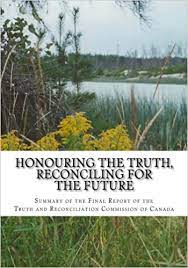We all knew it was true,
but there was something so onerous,
so disgraceful,
so damning,
that few wanted to use the word.
The term had been dropped from time to time.
Usually by the victims,
seldom by the perpetrators,
never by the governing authorities.
How could we say such a thing
about our past,
about our history,
about ourselves?
Sure, we made mistakes,
but not of the depth of the Nazis!
Yes, there had been deaths,
but not with the calculated brutality of the Khmere Rouge!
We know that many children died,
but this isn’t Rwanda!
There were no concentration camps.
No incinerators.
No mass murders.
No mass graves.
Wait.
No mass graves?
But still, this was not a program
of ethnic cleansing,
or the extermination of a whole people
as if they were vermin.
So the word was avoided.
The word was always dismissed as gross overstatement.
Until The Truth and Reconciliation Commission.
There it was, on the very first page:
 “For over a century, the central goals of Canada’s Aboriginal policy were to eliminate Aboriginal governments; ignore Aboriginal rights; terminate the Treaties; and, through a process of assimilation, cause Aboriginal peoples to cease to exist as distinct legal, social, cultural, religious, and racial entities in Canada. The establishment and operation of residential schools were a central element of this policy, which can best be described as “cultural genocide.””
“For over a century, the central goals of Canada’s Aboriginal policy were to eliminate Aboriginal governments; ignore Aboriginal rights; terminate the Treaties; and, through a process of assimilation, cause Aboriginal peoples to cease to exist as distinct legal, social, cultural, religious, and racial entities in Canada. The establishment and operation of residential schools were a central element of this policy, which can best be described as “cultural genocide.””
(Truth and Reconciliation Commission of Canada, 2015, Honouring the Truth, Reconciling for the Future, p. 1)
Cultural Genocide.
What else could we name a policy that sought
to “Kill the Indian” in the child,
by removing them from their families,
forbidding the use of their language,
indoctrinating them into the worldview of their colonial masters,
enculturating them into the habits of colonial life,
and incarcerating them in residential schools?
Cultural Genocide.
There is no other way to name it.
There is no other way to tell the truth.
But there is always a fine line
between cultural and physical genocide.
If cultural assimilation doesn’t work,
if the child is resistant,
if the “patterns of savagery” are too deep,
if the child will not comply,
if the Indian in the child will not die,
then, well, the only remaining option
is for the Indian to die.
We always knew this, didn’t we.
We may have taken a strange comfort
in the term “cultural genocide.”
Yes, it was terrible.
Yes, there continues to be generational trauma.
Yes, we didn’t go looking for the truth about
how so many children didn’t come home.
Yes, we turned a blind eye to the
murdered and missing Indigenous women and girls.
Yes, cultural genocide is a terrible blight
on our history,
on our story,
on our Canadian identity.
But there were no mass graves.
Or at least, they hadn’t been found.
Until now.
Cultural genocide is too polite.
Cultural genocide is too easy.
Cultural genocide is too comfortable.
It has been six years since The Truth and Reconciliation Commission
finally named what Indigenous peoples had known
for more than a hundred years.
Colonial “Indian policy” was consistently
in service of cultural genocide.
But now we know that there is no need
for the modifier, “cultural.”
It was genocide.
And like all genocide,
like all idolatrous colonialism,
there is always a hunger
for child sacrifice.
Genocide.
Pedicide.
In Canada, this Thursday, September 30,
is the first National Day for Truth and Reconciliation.
There is no reconciliation without truth.
And for this first day of commemoration,
there is more devastating truth to acknowledge and mourn.
And there is no reconciliation
without repentance, remorse, and restitution.
So find a public event for this day, friends.
Stand in the solidarity of grief and guilt.
Listen to the drums and the singing.
Humble yourselves before your neighbours.
And pray for healing.
Begin your learning journey into Truth and Reconciliation here.
Andrew Stephens-Rennie has also developed another list of resources here.